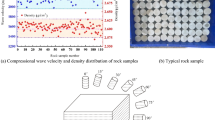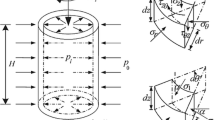Abstract
This paper presents an experimental study concerning the relevance of mechanical characteristics and bedding planes of sand. The study was carried out using a new method of specimen fabrication based on the capillary effect. A series of triaxial tests were performed to study the stress-strain behavior of sand under different bedding plane tilting angles. The results show that the peak deviatoric stress and the volumetric strain are significantly different under different bedding plane tilting angles due to the inherent anisotropy of sand, and the difference between their peak strengths can reach 30%. The specimen reached the failure stage more easily and the peak strength was lower, reaching the residual state earlier when the bedding plane tilting angle was close to 45°-ϕ/2. The equation proposed in this study can thus reasonably reflect the relationship between the bedding plane tilting angle and the peak strength. The inherent anisotropy due to the bedding plane of sand may have a significant influence on the deformation of building foundations; therefore, neglecting this factor may lead to unsafe designs.
















Similar content being viewed by others
References
Casagrande A, Carillo N (1944) Shear failure of anisotropic materials. Journal of the Boston Society of Civil Engineers 31:74–87
Dong T, Zheng YR, Kong L, Zhe M (2018) Strength criteria and slipping planes of anisotropic sand considering direction of major principal stress. Chinese Journal of Geotechnical Engineering 40:736–742
Duncan JM, Seed HB (1966) Strength variation along failure surfaces in clay. J Geotech Eng Div ASCE 92:81–104
Escribano DE, Nash DFT (2015) Changing anisotropy of G0 in Hostun sand during drained monotonic and cyclic loading. Soils Found 55:974–984
Haruyama M (1985) Drained deformation-strength characteristics of loose Shirasu (volcanic sandy soil) under three-dimensional stresses. Soils Found 25:65–76
Huang M, Chen Z, Lu X (2018) Bifurcation prediction of shear banding in sand with non-coaxial critical state model considering inherent anisotropy. Soils & Foundations S0038080618300386
Ishihara K, Okada S (1978) Yielding of overconsolidated sand and liquefaction model under cyclic stresses. Soil Found 18:57–72
Ishihara K, Okada S (1982) Effects of large preshearing on cyclic behavior of sand. Soil Found 22:109–125
Leng Y, Luan MT, Xu CS (2008) A comparative study of drained and undrained shear behavior of saturated sands. Journal of Disaster Prevention and Mitigation Engineering 28:144–151
Liu Y (2013) Anisotropic strength criteria of sand: stress-induced anisotropy. Chinese Journal of Geotechnical Engineering 35:460–468
Luan MT, Xu CS, He Y, Guo Y, Li MG (2006) Experimental study on effect of orientation of the principal stress on undrained behavior of saturated loose sand under monotonic shearing. Chinese Journal of Geotechnical Engineering 28:1085–1089
Luo Q (2013) Numerical application and centrifugal modeling study of a non-coaxial constitutive model. Dissertation, Dalian university of technology
Oda M, Koishikawa I (1979) Effect of strength anisotropy on bearing capacity of shallow footing in a dense sand. Soils Found 19:15–28
Oda M, Koishikawa I, Higuchi T (1978) Experimental study of anisotropic shear strength of sand by plane strain test. Soils Found 18:25–38
Patil UD, Puppala AJ, Hoyos LR, Banerjee A (2018) Strength, stiffness and radial anisotropy of compacted silty sand under suction-controlled axisymmetric shearing. Geotech Geol Eng 36:3945–3960 https://link.springer.com/article/10.1007/s10706-018-0590-z
Sun Q, Dong QY, Cai YQ, Wang J, Hu XQ (2015) Deformation of fully saturated sand under simultaneous variations of deviatoric stress ratio and principal stress rotational angle. Rock Soil Mech 36:2261–2269
Tong ZX, Zhou SP, Yao YP, Shi G (2012) An improved direct shear apparatus for shear strength of anisotropic sands and its primary application. Chin J Rock Mech Eng 31:2579–2584
Vaid YP, Chung EKF, Kuerbis RH (1989) Preshearing and undrained response of sands. Soil Found 29:49–61
Yamada Y, Ishihara K (1979) Anisotropic deformation characteristics of sand under three-dimensional stress conditions. Soils Found 19:79–94
Yang YM, Yu HS (2010) Numerical simulations of simple shear with non-coaxial soil models[J]. International Journal for Numerical & Analytical Methods in Geomechanics 30:1–19
Yoshimine M, Ishihara K, Vargas W (1998) Effects of principal stress direction and intermediate principal stress on undrained shear behavior of sand. Soils Found 38:179–188
Zeng HJ, Wang ZT, Luo Q, Luan MT, Guo Y (2012) Introduction to a new sand pourer and its control element analysis. Yangtze River 43:66–70
Acknowledgments
We thank Professor Lei MT, Institute of Karst Geology, CAGS, for his valuable suggestions for the revision of this paper.
Author information
Authors and Affiliations
Corresponding author
Rights and permissions
About this article
Cite this article
Tang, Z., Luo, Q., Feng, C. et al. Experimental investigation of the influence of bedding planes on the mechanical characteristics of saturated sand. Bull Eng Geol Environ 80, 641–651 (2021). https://doi.org/10.1007/s10064-020-01924-6
Received:
Accepted:
Published:
Issue Date:
DOI: https://doi.org/10.1007/s10064-020-01924-6




